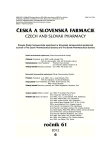Comparison of sanguinarine production in suspension cultures of the Papaveraceae plants
Authors:
František Bilka; Andrea Balážová; Andrea Bilková; Ivana Holková
Published in:
Čes. slov. Farm., 2012; 61, 267-270
Category:
Original Articles
Článok venujeme našej učiteľke a kolegyni doc. RNDr. Márii Benešovej, CSc., k jej životnému jubileu.
Overview
Intact plants of the Papaveraceae family are producers of a whole range of benzylisoquinoline alkaloids, which are used in pharmaceutical industry. In vitro cultures derived from plants of the Papaveraceae do not have the ability to produce such a broad spectrum of alkaloids, only the biosynthetic pathway leading to sanguinarine is active. This study deals with the preparation of in vitro cultures of Papaver somniferum, Eschscholtzia californica, Chelidonium majus and Macleaya cordata. Their sanguinarine production abilities were tested and compared. The lowest amounts of sanguinarine from all cultures tested were accumulated in suspension cultures of the opium poppy (0.45–0.55 μg in 1 g of fresh weight). Eschscholtzia californica, Chelidonium majus and Macleaya cordata cultures produced similar amounts of sanguinarine (18.0–22.7 μg; 20.5–26.3 μg; 15.4–20.3 μg in 1 g of fresh weight, resp.). The elicitation study used a biotic stressor, Botrytis cinerea hydrolysate. In all cultures treated, an increase in sanguinarine accumulation was observed. Of all cultures tested, the most intensive response was observed in the opium poppy cultures, although the amount of sanguinarine in the elicited poppy cultures was lower than in the non-elicited samples of the other cultures.
Key words:
Papaver somniferum • Eschscholtzia californica • Chelidonium majus • Macleaya cordata • suspension cultures • elicitation • sanguinarine
Received 25 October 2012 / Accepted 17 November 2012
Sources
1. Sikyta B., Dušek J. Biotechnologie pro farmaceuty. 3. vyd. Praha: Univerzita Karlova – Nakladatelství Karolinum 2001; 125 s.
2. Tůmová L., Polívková D. Vliv AgNO3 na produkci flavonoidů kulturou Ononis arvensis L. in vitro. Čes. slov. Farm. 2006; 55, 186–188.
3. Siatka T., Kašparová M. Effects of aluminium chloride on cell growth and production of coumarins in cell suspension cultures of Angelica archangelica L. Čes. slov. Farm. 2010; 59, 112–116.
4. Hodges R., Rapoport H. Morphinane alkaloids in callus cultures of Papaver somniferum. J. Nat. Prod. 1982; 45, 481–485.
5. Facchini P. J., Bird D. A. Developmental regulation of benzylisoquinoline alkaloid biosynthesis in opium poppy plants and tissue cultures. In Vitro Cell. Dev. Biol. – Plant 1998; 34, 69–79.
6. De-Eknamkul W., Zenk M. H. Purification and properties of 1,2-dehydroreticuline reductase from Papaver somniferum seedlings. Phytochemistry 1992; 31, 813–821.
7. Facchini P. J., Hagel J. M., Liscombe D. K., Loukanina N., MacLeod B. P., Samanani N., Zulak K. G. Opium poppy: blueprint for an alkaloid factory. Phytochem. Rev. 2007; 6, 97–124.
8. Zdařilová A., Malíková J., Dvořák Z., Ulrichová J., Šimánek V. Kvartérní isochinolinové alkaloidy sanguinarin a chelerytrin. Účinky in vitro a in vivo. Chem. Listy 2006; 100, 30–41.
9. Dvořák Z., Šimánek V. Metabolism of sanguinarine: The facts and the myths. Current Drug Metabolism 2007; 8, 173–176.
10. Murashige T., Skoog F. A revised medium for rapid growth and bioassays with tobacco tissue cultures. Physiol. Plantarum 1962; 15, 473–497.
11. Mc Kinley T. C., Michaelis P. J., Flores H. E. Is lipoxygenase involved in polyacetylene biosynthesis in Asteraceae? Plant Physiol. Biochem. 1993; 31, 835–843.
12. Dubois M., Gilles K. A., Hamilton J. K., Rebers P. A., Smith F. Colorimetric method for determination of sugars and related substances. Anal. Chem. 1956; 28, 350–356.
13. Bilková A., Bilka F., Blanáriková V., Bezáková L. Effect of excess of cupric sulfate on sanguinarine formation and activities of amine oxidase and polyphenol oxidase in cell suspension cultures of Papaver somniferum. Biologia 2005; 60, 661–664.
14. Balažová A., Bilka F., Blanáriková V., Pšenák M. Zmeny obsahu sanguinarínu a aktivity polyfenoloxidázy vplyvom fungálneho elicitora v suspenzných kultúrach maku siateho Papaver somniferum L. Čes. slov. Farm. 2002; 51, 182–185.
15. Holková I., Bezáková L., Bilka F., Balažová A., Vanko M., Blanáriková V. Involvement of lipoxygenase in elicitor-stimulated sanguinarine accumulation in Papaver somniferum suspension cultures. Plant Physiol. Biochem. 2010; 48, 887–892.
16. Balažová A., Blanáriková V., Bilka F., Bilková A., Kiňová Sepová H. Efekt troch rôznych elicitorov na produkciu sanguinarínu suspenznými kultúrami nízko-morfínovej odrody maku siateho (Papaver somniferum L.). Čes. slov. Farm. 2011; 60, 237–240.
17. Ondrejčák F. Slovenské odrody maku siateho. http://www. makovepole.sk/index.php/mak-siaty/slovenske-odrody-maku-siateho (18. 10. 2012).
18. Desgagné-Penix I., Facchini P. J. Benzylisoquinoline alkaloid biosynthesis. In: Ashihara H., Crozier A., Komamine A. eds. Plant Metabolism and Biotechnology, 1st ed. Chichester (UK): John Wiley and Sons, Ltd., 2011.
19. Angelova S., Buchheim M., Frowitter D., Schierhorn A., Roos W. Overproduction of alkaloid phytoalexins in california poppy cells is associated with the co-expression of biosynthetic and stress-protective enzymes. Molecular Plant 2010; 3, 927–939.
20. Bilka F., Vanko M., Balažová A., Bilková A., Holková I. Charakterizácia polyfenoloxidázy z latexu lastovičníka väčšieho (Chelidonium majus L.). Čes. slov. Farm. 2007; 56, 90–94.
21. Koreňová M., Stano J., Mičieta K., Barth A., Nemec P., Blanáriková V. Štúdium imobilizovanej a extracelulárnej dipeptidylpeptidázy IV Chelidonium majus. Chem. Listy 2012; 106, 847–850.
22. Stano J., Mičieta K., Koreňová M., Blanáriková V. Štúdium vybraných extracelulárnych a imobilizovaných aminopeptidáz lastovičníka. Chem. Listy 2007; 101, 65–69.
Labels
Pharmacy Clinical pharmacologyArticle was published in
Czech and Slovak Pharmacy

2012 Issue 6
Most read in this issue
- Evaluation of content uniformity of tablets with a low content of the active ingredient with a narrow therapeutic index
- Analysis of pharmaceutical care in dispensing of over-the-counter orlistat
- Halloysite – interesting nanotubular carrier for drugs
- Comparison of sanguinarine production in suspension cultures of the Papaveraceae plants
